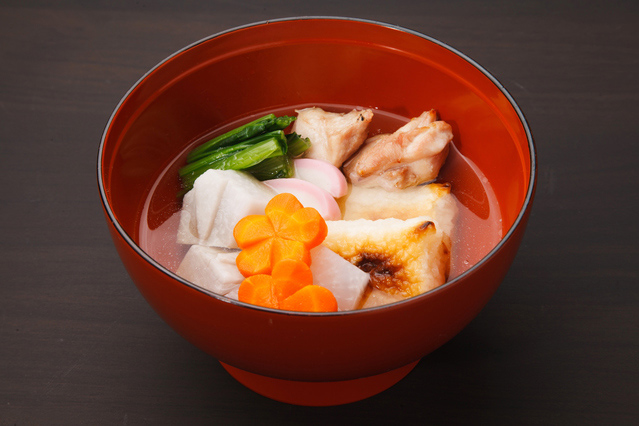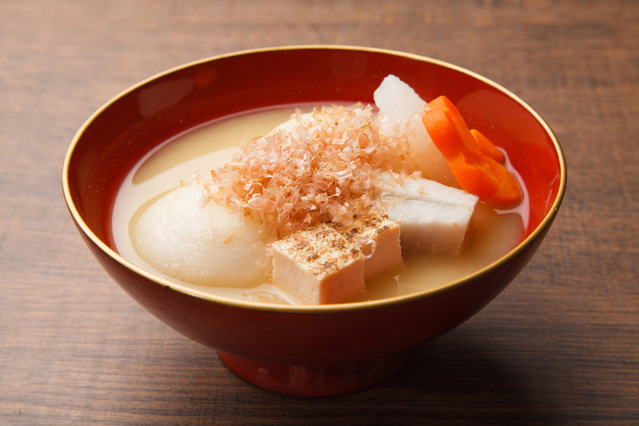
Zoni is a Japanese traditional new year soup consisting mainly of mochi (rice cakes) and other ingredients like vegetables etc in a soy sauce or miso based broth. This soup is eaten on New Year's Day along with a traditional new year dish called Osechi, an assortment of colorful dishes packed together in special boxes. It is believed that people eat these dishes as a tradition of praying for the safety of the year. However, each region has different zoni and the ingredients used are unique to each area. It's interesting to see from the historical point of view on how each region got its own local colors.
-
01
History
The history of Zoni or Ozoni, a New Year’s traditional soup dates back to the Heian period (794-1185). Mochi (rice cakes) used in the zoni has long been considered a food eaten by the farmers on “hare”, which means sunny days or special occasions. They played on the word, “Hare” which means sunny/clear weather/formal/ceremonial since having good weather meant farming went well for farmers. It is said that zoni began when these farmers cooked rice cakes, taro, carrots, radish along with other vegetables which they harvested as an offering to the gods at the beginning of the year.
By the Muromachi period (1333-1573), zoni was served at auspicious occasions which indicates that it has gradually become a part of Japanese culture over time. -
02
Reasons behind eating zoni
While there are many theories, some say that in the old days, there was a belief that by eating warm food and keeping the stomach warm, the five organs, including the stomach and intestines, would be kept healthy and free from disease. Eating hot soup with mochi (rice cake) on New Year's Day was a way of wishing for good health and happiness for the year.
On the other, another theory says that during the Muromachi period (1336-1573), zoni was always served as the first dish, but rice was expensive at that time, so the common people usually had taro instead of mochi. By the beginning of the Edo period (1603-1868), when mochi became affordable to the general public, it was more less always put in the zoni as a symbol of wealth, in a way. -
03
Types of Soup
In western Japan (except the Kinki region) and the Kanto region, the most common type of zoni is Sumashi-jiru. This Sumashi-jiru or Osumashi, is a clear soup made from Dashi soup stock mainly seasoned with soy sauce and salt. Tokyo is a place where many different cultures come together, so even within Tokyo, the Kanto styled Sumashi-jiru zoni are slightly different. For example, in Shinagawa and Ota wards, a piece of nori (seaweed) is placed on top of the zoni, which is due to the fact that the area was a source of nori. In Toda City, Saitama Prefecture, a kinpira burdock is placed on top of Kanto-style zoni, and in the coastal area of Kujukurihama in Chiba Prefecture, a type of seaweed called "haba-nori" is used.
![Basic sumashi-jiru style zoni eaten in Kanto region]()
Basic sumashi-jiru style zoni eaten in Kanto region
In comparison, in the Izumo region, there is a type of zoni that looks like zenzai, called azuki-zoni. Azuki-zoni is a sweet red bean soup served hot with mochi (rice cake) or shiratama dango (glutinous rice flour dumplings). Similarly, in some parts of Kagawa prefecture on the island of Shikoku, white miso based zoni has a mochi with red bean paste. This is very rare and unique to the area. In the Edo period (1603-1868), Kagawa's specialties were sugar, salt, and cotton, known as the "Sanpaku of Sanuki (Sanuki's Three Whites)”. Sugar was very expensive and for the ordinary people to hide the fact that they are eating it was to place it inside the mochi. And hence, this rare zoni was said to be born.
![Kagawa style zoni with mochi stuffed with red bean paste]()
Kagawa style zoni with mochi stuffed with red bean paste
The Kansai region is especially famous for its zoni, especially Kyoto. The zoni from these regions usually use sweet white miso. Not only the mochi (rice cake) is round, but all the ingredients such as radish and carrots are also cut round, with the corners removed.
In Kyoto, where there are many temples, zoni is made in the Buddhist vegetarian style known as Shojin-ryori where chicken is not added. In Nara, meat and fish are also not included and only kombu broth is used instead of bonito. Instead of using animal products, Nara's zoni is served with a separate dish of kinako (soybean flour). Here, the mochi is not eaten with the other ingredients, but rather removed from the soup bowl and eaten as kinako mochi.![Basic kansai style zoni using white miso based broth]()
Basic kansai style zoni using white miso based broth
![Nara style zoni]()
Nara style zoni
Going up North, in Iwate prefecture, there is a type of zoni called "walnut-zoni," which is a two-bowl set of zoni served with a sauce made of ground walnuts seasoned with sugar and soy sauce and served with mochi. In Hokkaido, a wide variety of zoni are eaten due to the fact that people from all over Japan gathered there after the Kaitakushi mission was established in the Meiji era. In some parts of Kagoshima, the shape of the mochi used in Zoni is a mixture of square and round. In Okinawa, they have not had the custom of eating it since ancient times. Like so, there are many more unique zoni depending on the regions.
![Iwate style walnut-zoni]()
Iwate style walnut-zoni
![]()
-
04
Types of Mochi Used
The Kansai region tends to have round mochi, while the Kanto region and some colder regions tend to have square mochi. It is thought that this is because during the Edo period (1603-1868), when the population was concentrated in the Kanto area, square mochi, which can be made in large quantities at once, were used rather than round ones, which are made one at a time by hand. There is also a theory that the western part of Japan was divided into round mochi and the eastern part into square mochi due to the Battle of Sekigahara. In Gifu, Mie and Shiga prefectures, there is a mixture of round and square mochi even within the same prefecture, which may be an interesting feature of the border area. In Kagawa and Ehime, mochi with red bean paste are used. In addition to the different shapes, the difference between baked and boiled mochi is also an important point that greatly affects the overall flavor and texture of zoni.
![]()
-
05
Ingredients Used
In addition to the usual vegetables such as radishes, carrots, and leeks, many use the local produce of their areas to accompany the mochi. For example, wild vegetables and mushrooms are used in Tohoku, salmon and salmon roe in Niigata, green laver in Chiba, rock laver and clams in Shimane, and oysters in Hiroshima. In the Kanto region, chicken and Japanese mustard spinach are used.
-
06
Meanings of Ingredients
It is believed that round mochi is a symbol for family happiness and long life due to its stretchability. On the other, a square mochi symbolizes the prosperity of the house. Taro symbolizes prosperity of descendants due to its rapid growth producing many crops per year. And carrots, being red in color, have the effect of warding off evil. Like so, in the olden days, people used to give meaning to each ingredient in their ozoni as it is eaten on auspicious occasions.
![]() READ MORE
READ MORE- New Year in Japan: A Cultural Guide for Participating in Japanese New Year’s Traditions
-
![]()
- Need to Know
The Tokyo Station Hotel
1-9-1 Marunouchi, Chiyoda-ku Tokyo
 READ MORE
READ MORE- Top 10 Shrines and Temples to Visit in the New Year 2024
-
![]()
- Shrines










 Go here
Go here











